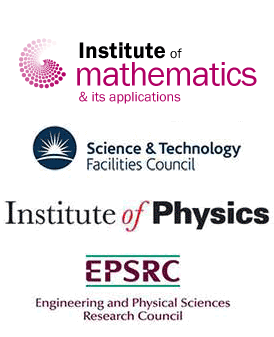Bayfordbury Observatory
Bayfordbury Observatory is the University of Hertfordshire's teaching observatory for astronomy and astrophysics.
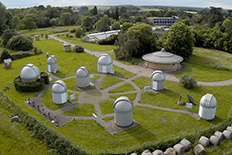 It is one of the best equipped and largest teaching observatories in the country and features:
It is one of the best equipped and largest teaching observatories in the country and features:
- 7 large, individually-housed optical telescopes
- 4 radio telescopes, including a 3-element interferometer
- Solar telescopes in dedicated dome
- High definition indoor planetarium and two inflatable planetariums
- Atmospheric remote-sensing platform
- Unrivalled student access both hands on, and remotely
- Extensive student-led outreach programme
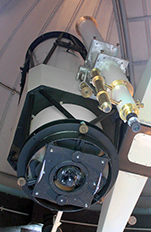 Situated approximately 6 miles from the main campus in Hatfield, Bayfordbury is regarded as one of the finest astronomical teaching observatories in the country.
Situated approximately 6 miles from the main campus in Hatfield, Bayfordbury is regarded as one of the finest astronomical teaching observatories in the country.
The observatory has formed an integral part of the University of Hertfordshire's astronomy-related degree programmes since it opened in 1970 and is used by our students from the first week of their degree through to their final year, when it can also be used for their final year projects.
The 7 large optical telescope allow students to observe detailed images of objects in space - from the nearby Sun, Moon, planets and asteroids, through star clusters and nebulae, to galaxies hundreds of millions of light-years away.
They can be equipped with a variety of research-grade CCD cameras, high resolution spectrographs or high frame-rate video cameras. Three telescopes are also able to be operated roboitcally, and students and staff can request observations remotely and have images taken automatically when the weather allows.
Our 4.5-metre radio telescope and 3-dish 115-metre baseline interferometer allow a completely different view of the universe. These are connected to 21cm line receivers, to detect the neutral hydrogen in the galaxy and extragalactic radio sources.
Find out more about our telescopes.
Remote Sensing Observatory
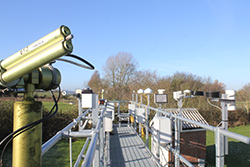 Since 2010 the University has used the Bayfordbury campus as its atmospherics remote sensing observatory.
Since 2010 the University has used the Bayfordbury campus as its atmospherics remote sensing observatory.
Operated by the Centre for Atmospheric and Climate Physics Research (CACP), remote sensing instruments currently installed include:
- LiDAR
- Sun and Moon photometers
- Electric Field Mill
- Pyranometer and pyrgeometer
- GNSS meteorology receiver
- Particle counter
- Day and night All-sky cameras
- Infrared radiometers
Find out more about remote sensing.
Why Bayfordbury?
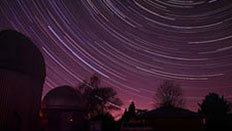 When the Hatfield Polytechnic (which later became the University of Hertfordshire) was looking for a site for their new observatory in 1969, Bayfordbury was chosen as the best option.
When the Hatfield Polytechnic (which later became the University of Hertfordshire) was looking for a site for their new observatory in 1969, Bayfordbury was chosen as the best option.
The observatory is set in the 372 acre Bayfordbury estate, near Hertford, composed largely of university-owned woodland and Grade II listed parkland. The surrounding countryside helps with dark, steady skies for our optical telescopes, and less interference for our radio telescopes.
Whilst many universities are set it cities with large amounts of light pollution and have the telescopes set within them, Bayfordbury is situated far enough away from the town of Hatfield to escape the glare of street lights and allowing us to be one of the most capable teaching observatories in the country.
Don't just take our word for it, have a look at some of the photos taken from Bayfordbury to see how good our skies are.
Our proximity to London means the skies over Bayfordbury aren't perfect, but they're some of the best in the area, and get noticeably darker after midnight with Hertfordshire County Council converting 70% of streetlights to part-time use to reduce costs and carbon emissions.
In 2010 the university's Centre for Atmospheric and Instrumentation Research decided to use Bayfordbury as the location for its remote sensing observatory, due to clear countryside air and existing facilities.
Bayfordbury is 6 miles from the main campus in Hatfield, allowing all of the benefits of a dark, countryside location, but being just a short 15 minute drive away. Although it is open to students every night, we understand not everybody has readily accessible transport, which is why we have automated telescopes that operate over the internet, so they are accessible to our students at any time, from anywhere.



